View in other NatureServe Network Field Guides
NatureServe
Montana
Utah
Wyoming
Idaho
Wisconsin
British Columbia
South Carolina
Yukon
California
New York
Entire-leaved Avens - Dryas integrifolia
State Rank Reason (see State Rank above)
Known in Montana from the Big Snowy Mountains and possibly from the Tobacco Root Mountains, though location of this latter specimen collection is unknown and cannot be confirmed. Current population levels and trends are unknown. However, its high-elevation habitat is relatively inaccessible, and there does not appear to be any significant threats.
- Details on Status Ranking and Review
Population Size
Score2-3 - Very Small to Small: Population size is imprecisely known but is believed to be <10,000 individuals.
Range Extent
Score1 - Peripheral, Disjunct or Sporadic Distribution in MT: Widespread species that is peripheral, disjunct or sporadically distributed within MT such that it occurs in <5% of the state (<7,500 sq. miles or the combined area of Beaverhead and Ravalli Counties) or is restricted to 4-5 sub-basins.
Area of Occupancy
Score3 - Very Low: Generally occurring in 3 or fewer Subwatersheds (6th Code HUC’s).
Environmental Specificity
Score1-2 - Moderate to High.
Trends
Score0-1 - Stable to Minor Declines:
CommentPopulation trends are unknown, though habitat appears to be stable.
Threats
Score0-1 - Low to Medium.
Intrinsic Vulnerability
Score1-2 - Moderate to High Vulnerability.
Raw Conservation Status Score
Score
8 to 13 total points scored out of a possible 19.
General Description
Entire-leaved Avens is a mat-forming shrub with prostrate stems which bear naked flower stems that reach up to 10 cm high and arise from leaf rosettes. The leaves have short stalks and lance-shaped blades that are 8-15 mm long with margins that are turned under and entire on the upper half. The upper leaf surface is glabrous, while the lower surface is densely covered with white hair, but glands are absent. The solitary, saucer-shaped, white flowers have a glandular, 5-lobbed calyx and 8-10 spreading, elliptic petals that are ca. 1 cm long. There are numerous stamens and styles. The latter become feathery and 2-4 cm long as the achenes mature.
Phenology
Flowering in July.
Diagnostic Characteristics
The more common D. hookeriana is similar, but the leaves have wavy margins to the tip, are broadest near mid-length, and have light brown glands mixed in with the white hair on the undersides of the leaves. Our plants may show introgression with Dryas hookeriana, as they may be partially crenate-margined.
Species Range
Montana Range
Range Descriptions
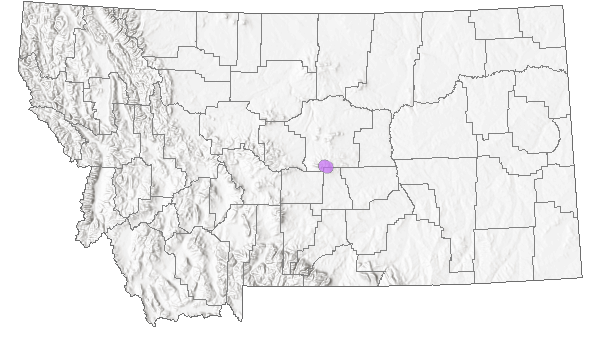
 Native
Native
Range Comments
Arctic North America and Greenland, south to New Hampshire, British Columbia, Alberta, and northern Montana. Peripheral.
Observations in Montana Natural Heritage Program Database
Number of Observations: 2
(Click on the following maps and charts to see full sized version)
Map Help and Descriptions
Relative Density
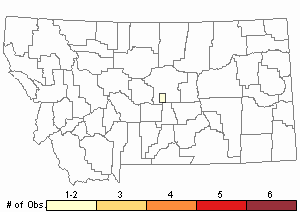
Recency
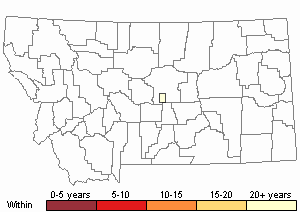

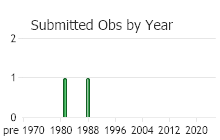
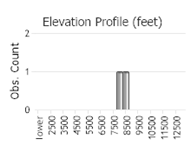 (Observations spanning multiple months or years are excluded from time charts)
(Observations spanning multiple months or years are excluded from time charts)
Habitat
Stony, limestone-derived soil of exposed ridges and plateaus in the alpine zone.
Ecological Systems Associated with this Species
- Commonly Associated with these Ecological Systems
Alpine Systems
Stewardship Responsibility
Threats or Limiting Factors
STATE THREAT SCORE REASON
Threat impact not assigned because threats are not known (MTNHP Threat Assessment 2021).
References
- Literature Cited AboveLegend:
 View Online Publication
View Online Publication MTNHP Threat Assessment. 2021. State Threat Score Assignment and Assessment of Reported Threats from 2006 to 2021 for State-listed Vascular Plants. Botany Program, Montana Natural Heritage Program, Helena, Montana.
MTNHP Threat Assessment. 2021. State Threat Score Assignment and Assessment of Reported Threats from 2006 to 2021 for State-listed Vascular Plants. Botany Program, Montana Natural Heritage Program, Helena, Montana.
- Additional ReferencesLegend:
 View Online Publication
View Online Publication
Do you know of a citation we're missing? Bamberg, S. A. 1964. Ecology of the vegetation and soils associated with calcareous parent material in the alpine region of Montana. Ph.D dissertation. University of California, Davis. 106 pp. (Diss. Abstr. 25:4370)
Bamberg, S. A. 1964. Ecology of the vegetation and soils associated with calcareous parent material in the alpine region of Montana. Ph.D dissertation. University of California, Davis. 106 pp. (Diss. Abstr. 25:4370) Bamberg, S. A., and J. Major. 1968. Ecology of the vegetation and soils associated with calcareous parent materials in three alpine regions of Montana. Ecological Monographs 38(2):127-167.
Bamberg, S. A., and J. Major. 1968. Ecology of the vegetation and soils associated with calcareous parent materials in three alpine regions of Montana. Ecological Monographs 38(2):127-167. Lesica, P., M.T. Lavin, and P.F. Stickney. 2012. Manual of Montana Vascular Plants. Fort Worth, TX: BRIT Press. viii + 771 p.
Lesica, P., M.T. Lavin, and P.F. Stickney. 2012. Manual of Montana Vascular Plants. Fort Worth, TX: BRIT Press. viii + 771 p. Lesica, P., M.T. Lavin, and P.F. Stickney. 2022. Manual of Montana Vascular Plants, Second Edition. Fort Worth, TX: BRIT Press. viii + 779 p.
Lesica, P., M.T. Lavin, and P.F. Stickney. 2022. Manual of Montana Vascular Plants, Second Edition. Fort Worth, TX: BRIT Press. viii + 779 p. S.G. Aiken, M.J. Dallwitz, L.L. Consaul, C.L. McJannet, L.J. Gillespie, R.L. Boles, G.W. Argus, J.M. Gillett, P.J. Scott, R. Elven, M.C. LeBlanc, A.K. Brysting and H. Solstad (1999 onwards). Flora of the Canadian Arctic Archipelago: Descriptions, Illustrations, Identification, and Information Retrieval. Version: 29th April 2003
S.G. Aiken, M.J. Dallwitz, L.L. Consaul, C.L. McJannet, L.J. Gillespie, R.L. Boles, G.W. Argus, J.M. Gillett, P.J. Scott, R. Elven, M.C. LeBlanc, A.K. Brysting and H. Solstad (1999 onwards). Flora of the Canadian Arctic Archipelago: Descriptions, Illustrations, Identification, and Information Retrieval. Version: 29th April 2003
- Web Search Engines for Articles on "Entire-leaved Avens"





